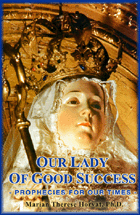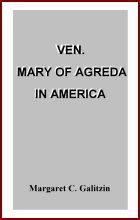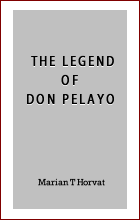American History
 |
 |
 |
 |
 |
 |
 |
Mary of Agreda in America - Part VII
Ven. Mary of Agreda: Her Influence
on Fr. Serra & California
In the last article we saw that there is strong evidence that Ven. Mary Agreda bilocated to instruct the Yokut and Ohlone Indians in the area of Mission Santa Cruz in northern California. (1)
While this claim of Ven. Mary of Agreda’s bilocation can only be confirmed by a long oral history among the early Indians of Mission Santa Cruz, there is documented and unquestionable evidence of the great influence the Conceptionist nun had on Father Junípero Serra and the other Franciscan missionaries of California.
An influence on Fr. Serra’s vocation
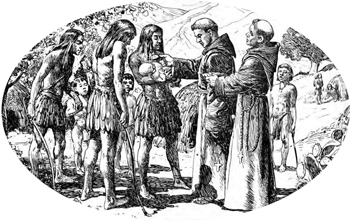 Fr. Serra’s desire to teach the Indians of New Spain in America was inspired by the writings of the Conceptionist nun. In particular, her Letter to the Missionaries in America, written in 1631, awakened desires in him to respond to
the call for stalwart men to labor for the conversion of the pagans in the New World. (2)
Fr. Serra’s desire to teach the Indians of New Spain in America was inspired by the writings of the Conceptionist nun. In particular, her Letter to the Missionaries in America, written in 1631, awakened desires in him to respond to
the call for stalwart men to labor for the conversion of the pagans in the New World. (2)
Impressed by her words that Providence had ordained that the Indians, “only upon looking at his sons [the Franciscans], will convert to our Holy Catholic Faith,” (3) Fray Serra begged that same Providence to place him among the number of those missionary friars.
As a sign that it was God’s will that he follow this vocation, he asked that Our Lady and St. Francis Solano would intercede and touch the heart of another friar to accompany him on this long voyage. That volunteer soon appeared: Francisco Palou, his student and future biographer, confided this desire to accompany him in the missionary work in Mexico.
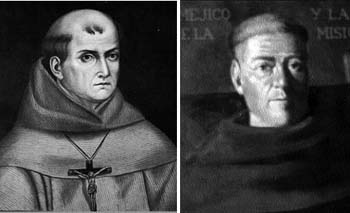 We see that Frey Palou was also well acquainted with the Conceptionist nun’s Letter, for he tells us that to be a missionary in the Americas is “a happiness so great that, in the opinion of the Venerable Mother Agreda, it is a state more to be desired than that of the Blessed. (4)
We see that Frey Palou was also well acquainted with the Conceptionist nun’s Letter, for he tells us that to be a missionary in the Americas is “a happiness so great that, in the opinion of the Venerable Mother Agreda, it is a state more to be desired than that of the Blessed. (4)
Clearly Mary of Agreda played a role to inspire the vocation of Fr. Serra and many other Franciscans who were moved by her words to become those first missionaries in the New World, or “this last corner of the earth,” as Fr. Serra described it in a letter. (5)In the first Franciscan College of Santa Cruz de queretaro, a faculty position was dedicated solely to the teaching of Ven. Mary of Agreda's writing. (6)
Fr. Serra, a devoté of the The Mystical City of God
The Mystical City of God was immensely popular among the Franciscans. First published in 1670, it became a familiar work in every seminary and library of the Order. Dictated by Our Lady to Mother Mariana, it was the Virgin herself who confirmed in it her Immaculate Conception and her mission of the co-redeemer of mankind.
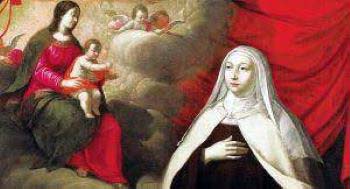 Certainly Fr. Serra was keenly aware of The Mystical City of God and its contents. In his native Mallorca, the friar’s first formal lecture delivered in 1740 was an exhortation on the Immaculate Conception that included reference to Ven. Mary of Agreda. (7)
Certainly Fr. Serra was keenly aware of The Mystical City of God and its contents. In his native Mallorca, the friar’s first formal lecture delivered in 1740 was an exhortation on the Immaculate Conception that included reference to Ven. Mary of Agreda. (7)
Fr. Serra had his personal volumes of The Mystical City of God with him when he first arrived in New Spain, and it was his companion during the first five years in the Sierra Gorda region where he founded five missions. More than one copy was in the College of San Fernando in Mexico City where he was administrator for the next 15 years.
We can see the importance Fr. Serra placed on both the person and the writing of Ven. Mary of Agreda from the figures on the stone façade of the church he founded in Landa in Central Mexico in 1760.
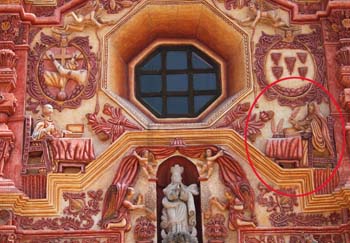 Above the entrance of Nuestra Señora de la Purísima Concepción del Agua, the central figure of the Virgin Mary reigns; she is flanked to the right by Mother Mary of Agreda, seated, quill in hand, writing The Mystical City of God. On the other side is the other great defender of the Immaculate Conception, Duns Scotus.
Above the entrance of Nuestra Señora de la Purísima Concepción del Agua, the central figure of the Virgin Mary reigns; she is flanked to the right by Mother Mary of Agreda, seated, quill in hand, writing The Mystical City of God. On the other side is the other great defender of the Immaculate Conception, Duns Scotus.
When Fray Junípero was named President of the Alta California missions, he took care to install The Mystical City of God in the first missions of Alta California. Documents record the work’s presence in mission libraries as early as 1775. (9)
Following the counsels of Mary of Agreda
Palou’s Life of Fray Junípero illustrates well how seriously Fray Junípero took the words dictated by Our Lady to Ven. Mary of Agreda.
As we saw in the last article, when he rang the mission bell from the oak tree at the site of the future Mission San Antonio de Padua, one friar objected that it was a waste of energy. He replied that he desired that “the bell be heard in all the world, the desire expressed, indeed, by the Venerable Mother Mary of Jesus of Agreda.” (10) Before his eyes were the example and words of Ven. Mary of Agreda.
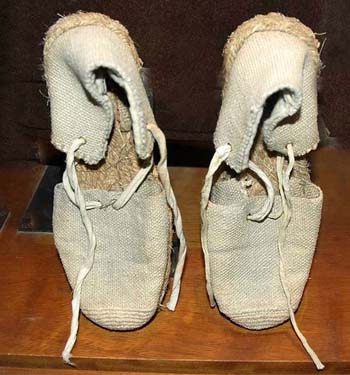 When Fr. Serra began his missionary work in Sierra Gorda, he discarded his ordinary sandals and took up the use of the hemp
espadrilles, which he would wear until they were completely worn out. Why did he do this? He was following the example of Christ, his disciple Palou records, “as the venerable Mother Mary of Jesus of Agreda tells us in her Mystical City (Part II, book 4, ch. 28, num. 685). (11)
When Fr. Serra began his missionary work in Sierra Gorda, he discarded his ordinary sandals and took up the use of the hemp
espadrilles, which he would wear until they were completely worn out. Why did he do this? He was following the example of Christ, his disciple Palou records, “as the venerable Mother Mary of Jesus of Agreda tells us in her Mystical City (Part II, book 4, ch. 28, num. 685). (11)
Her words in that grandiose work were imprinted on Fray Serra’s heart and memory. As Palou relates: “This divine doctrine [in The Mystical City of God] in this manner imprinted itself upon Serra’s heart ... thus did he set forth in his heart to imitate it, following the teaching to the extent he could, putting it into practice.” (12)
Fray Junípero seldom touched meat, satisfying himself with the fish, vegetables and fruit served. When questioned, he explained that he was merely imitating the life of Our Lady as she described it to Mother Mary of Agreda: “This fruit and the fish is the food which the Most Holy Virgin ate.” (13)
When Mission San Carlos Borromeo had to be moved from Monterey to Carmel for practical reasons, he entered into the laborious work of cutting the wood and carrying the timber. He did this, he told Fray Palou, to set the example so that the other missionaries “should not feel above performing similar manual duties when they have in view so noble an object, labors which are so very dear to God, as the Venerable Mother Mary of Jesus remarks in her Letter.” (14)
In this way did he model how he worked, lived and even ate following the words and counsels of Maria de Agreda. Her influence in California was profound, if not by her presence – and that possibility exists – then surely by her great work The Mystical City of God and her Letter to the Missionaries in America, that inspired so many Franciscans to enter the fruitful labor in the Americas.
Continued
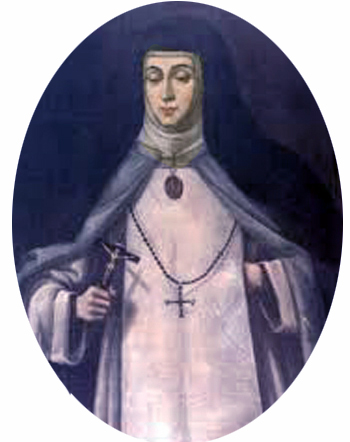

While this claim of Ven. Mary of Agreda’s bilocation can only be confirmed by a long oral history among the early Indians of Mission Santa Cruz, there is documented and unquestionable evidence of the great influence the Conceptionist nun had on Father Junípero Serra and the other Franciscan missionaries of California.
An influence on Fr. Serra’s vocation

Mary of Agreda foretold the Indians would receive the Faith from the Franciscan friars
Impressed by her words that Providence had ordained that the Indians, “only upon looking at his sons [the Franciscans], will convert to our Holy Catholic Faith,” (3) Fray Serra begged that same Providence to place him among the number of those missionary friars.
As a sign that it was God’s will that he follow this vocation, he asked that Our Lady and St. Francis Solano would intercede and touch the heart of another friar to accompany him on this long voyage. That volunteer soon appeared: Francisco Palou, his student and future biographer, confided this desire to accompany him in the missionary work in Mexico.

Fr. Junipero Serra & his disciple Fr. Francisco Palou
Clearly Mary of Agreda played a role to inspire the vocation of Fr. Serra and many other Franciscans who were moved by her words to become those first missionaries in the New World, or “this last corner of the earth,” as Fr. Serra described it in a letter. (5)In the first Franciscan College of Santa Cruz de queretaro, a faculty position was dedicated solely to the teaching of Ven. Mary of Agreda's writing. (6)
Fr. Serra, a devoté of the The Mystical City of God
The Mystical City of God was immensely popular among the Franciscans. First published in 1670, it became a familiar work in every seminary and library of the Order. Dictated by Our Lady to Mother Mariana, it was the Virgin herself who confirmed in it her Immaculate Conception and her mission of the co-redeemer of mankind.

Our Lady and Christ dictated to Mary of Agreda the Mystical City of God
Fr. Serra had his personal volumes of The Mystical City of God with him when he first arrived in New Spain, and it was his companion during the first five years in the Sierra Gorda region where he founded five missions. More than one copy was in the College of San Fernando in Mexico City where he was administrator for the next 15 years.
We can see the importance Fr. Serra placed on both the person and the writing of Ven. Mary of Agreda from the figures on the stone façade of the church he founded in Landa in Central Mexico in 1760.

Ven. Mary of Agreda writing the Mystical City of God on the façade of the Landa Mission Church
When Fray Junípero was named President of the Alta California missions, he took care to install The Mystical City of God in the first missions of Alta California. Documents record the work’s presence in mission libraries as early as 1775. (9)
Following the counsels of Mary of Agreda
Palou’s Life of Fray Junípero illustrates well how seriously Fray Junípero took the words dictated by Our Lady to Ven. Mary of Agreda.
As we saw in the last article, when he rang the mission bell from the oak tree at the site of the future Mission San Antonio de Padua, one friar objected that it was a waste of energy. He replied that he desired that “the bell be heard in all the world, the desire expressed, indeed, by the Venerable Mother Mary of Jesus of Agreda.” (10) Before his eyes were the example and words of Ven. Mary of Agreda.

Reading Mary of Agreda, Fr. Serra changed to hemp espadrilles for his missionary labors
Her words in that grandiose work were imprinted on Fray Serra’s heart and memory. As Palou relates: “This divine doctrine [in The Mystical City of God] in this manner imprinted itself upon Serra’s heart ... thus did he set forth in his heart to imitate it, following the teaching to the extent he could, putting it into practice.” (12)
Fray Junípero seldom touched meat, satisfying himself with the fish, vegetables and fruit served. When questioned, he explained that he was merely imitating the life of Our Lady as she described it to Mother Mary of Agreda: “This fruit and the fish is the food which the Most Holy Virgin ate.” (13)
When Mission San Carlos Borromeo had to be moved from Monterey to Carmel for practical reasons, he entered into the laborious work of cutting the wood and carrying the timber. He did this, he told Fray Palou, to set the example so that the other missionaries “should not feel above performing similar manual duties when they have in view so noble an object, labors which are so very dear to God, as the Venerable Mother Mary of Jesus remarks in her Letter.” (14)
In this way did he model how he worked, lived and even ate following the words and counsels of Maria de Agreda. Her influence in California was profound, if not by her presence – and that possibility exists – then surely by her great work The Mystical City of God and her Letter to the Missionaries in America, that inspired so many Franciscans to enter the fruitful labor in the Americas.
Continued

A profound influence on
California’s missions
- Ven. Mary of Agreda is documented as bringing the Holy Gospel to Indians in New Mexico, Arizona and Texas from 1620 to 1631. Mission Santa Cruz was founded in 1791. Therefore, the older Indians who recounted the stories of their parents and grandparents about the woman in Franciscan garb who came to teach them could well be referring to the Conceptionist nun known for her many bilocations to the New World.
- This letter of Ven. Mary of Agreda was published along with a foreword by Fr. Alonso de Benavides under the title Tanto que se sacó de una carta. It can be found in its entirety in the Appendix of Francisco’ Palou’s Life of Frey Junipero Serra, which can be read here.
- Anna M. Nogar, “Junípero Serra’s Mission Muse,” in The Worlds of Junipero Serra: Historical Contexts and Cultural Representations, University of California Press. Kindle Edition. Location 1844.
- Palou’s Life of Fray Junípero Serra, trans. by Maynard Geiger, OFM, Washington DC: Academy of American Franciscan History, 1955, pp. 7-8.
- Maynard Geiger, Franciscan Missionaries in Hispanic California, San Marino, Calif.: Huntington Library, 1969.
- Nogar, "Mission Muse," p. 74, Location 1687, Kindle Edition. >
- Anna M. Nogar, “Junípero Serra’s Mission Muse,” in The Worlds of Junipero Serra: Historical Contexts and Cultural Representations (Western Histories Book 10, p. 70). University of California Press. Kindle Edition. Location 1559f.
- Ibid., Location 1769-1771.
- Ibid., Location 1799-1809.
- Palou’s Life, p. 118.
- Ibid., p 288.
- Anna Nogar, “Junípero Serra’s Mission Muse,” Location 1570
- Palou’s Life, p. 118.
- Ibid., p. 123.

Posted June 22, 2024
______________________
______________________





